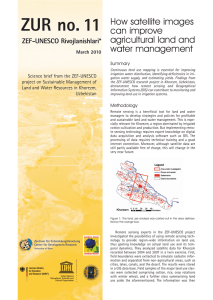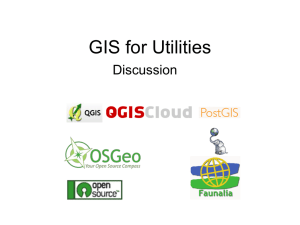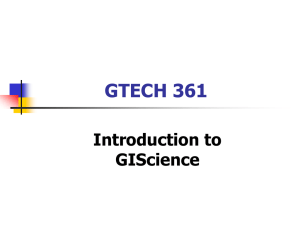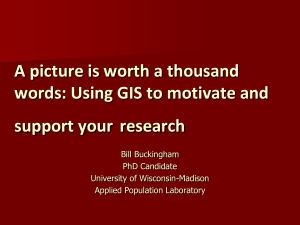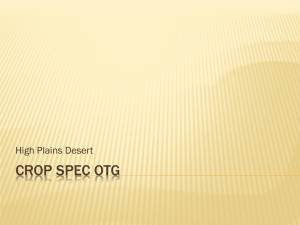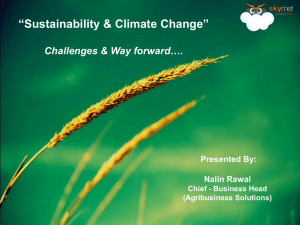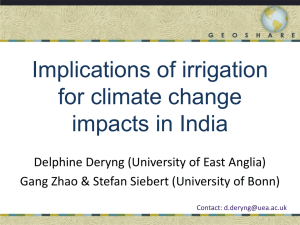Use of Remote Sensing and GIS in Agriculture and Related
advertisement
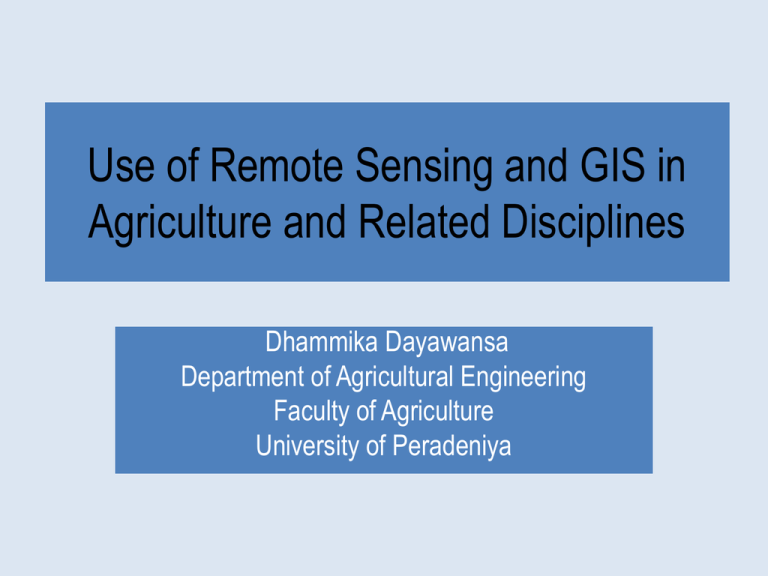
Use of Remote Sensing and GIS in Agriculture and Related Disciplines Dhammika Dayawansa Department of Agricultural Engineering Faculty of Agriculture University of Peradeniya Geo-Informatics Education at University of Peradeniya • Two postgraduate programmes – Postgraduate Institute of Agriculture - PGIA – Postgraduate Institute of Science – PGIS – Course on GIS and Remote Sensing for other postgraduate students – Applications in research • Undergraduate programmes – Courses on remote sensing and GIS are offered for the undergraduates in many faculties including Arts, Agriculture, Science and Engineering – Use of geo-informatics technology in undergraduate research • Short term training programmes Remote Sensing • acquisition of information of an object or a process, without physical contact Remote Sensing data sources Satellite images Aerial photographs Geographical Information Systems (GIS) A system that captures, stores, analyzes, manages, and presents data that are linked to locations Can relate different information in a spatial context Geo-Informatics and agriculture • Remote Sensing, GIS and allied disciplines can be used in – Assessment of crop area extent – Management of water resources – Identification of pest attacks and diseases – Yield assessment studies – Land suitability assessment for agriculture – Disaster management – Precision agriculture Assessment of crop area extent • Assessment of crop area extent is useful in yield forecasting, water and other input management • Satellite images can be used to identify the crops using – Visual interpretation – Digital image interpretation – Expert classification techniques – knowledge based classifier Assessment of crop area extent Paddy areas in Mahaweli System C with different false colour composites (FCCs) Paddy area extracted by visual interpretation of IRS LISS II images Paddy area extracted by supervised classification of IRS LISS III image Paddy area extracted by supervised classification of ASTER image Use of suitable satellite sensor in identification of crop areas is important to improve the accuracy of the output Management of water resources • Identification and mapping of surface water Infrared satellite images – Identification of surface water bodies Inventory of water bodies, reservoir capacity calculation, identifying seasonal fluctuations of water levels Identification of tank water levels and irrigation command areas Water resources management with RS and GIS • Irrigated lands assessment and inventory • Calculation of water requirement of crops and subsequent water budgeting for command areas • Assessment of water availability in rivers and reservoirs for optimal management to meet irrigation demand • Based on empirical relations with surface area, shoreline length and volume or based on topographic features Determine volume of water stored and change in the level with time Water resources management with RS and GIS - Delineation of water logged /saline areas - Identification of aquatic vegetation associated with water logging - Eutrophication and pollution monitoring Assessment of land degradation using Geo-Informatics Assessment of crop yield and yield forecasting Mostly based on vegetation indices such as Normalized Difference Vegetation Index (NDVI) - By developing relationships between yield & other crop parameters eg: canopy cover biomass content Identification of pest attacks and diseases Based on changes in pigmentation chlorophyll content leaf orientation vegetative characteristics tillering, branching Land suitability assessment for agriculture • Land suitability for a given crop is based on – Soil characteristics – Existing land use – Climatic factors such as rainfall and temperature – Topography – Availability of transportation facilities and agricultural labour – Availability of water sources for irrigation Land suitability assessment for agriculture • Land suitability can be assessed through the modeling capabilities available in GIS Disaster management - Disaster forecasting eg: Floods, Droughts, Cyclones, Forest fires - Disaster affected area estimations eg: Flooded area Drought prone agricultural lands Forest Fires Precision agriculture - To identify potential agricultural lands considering * water availability * Soil salinity, fertility * Topography Crop Health Soil Fertility - To identify fish resources in inland and marine aquaculture Remote Sensing Collaboration GIS Sustainable Agriculture Thank you very much for your attention
